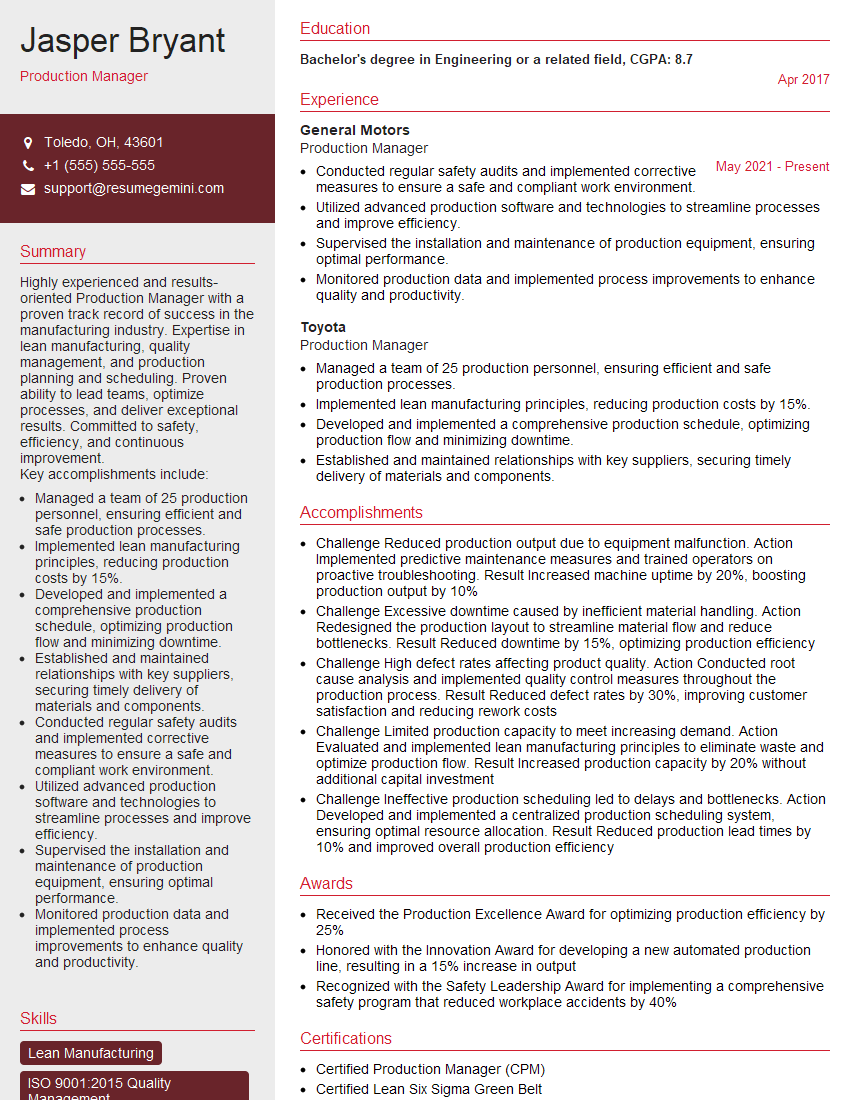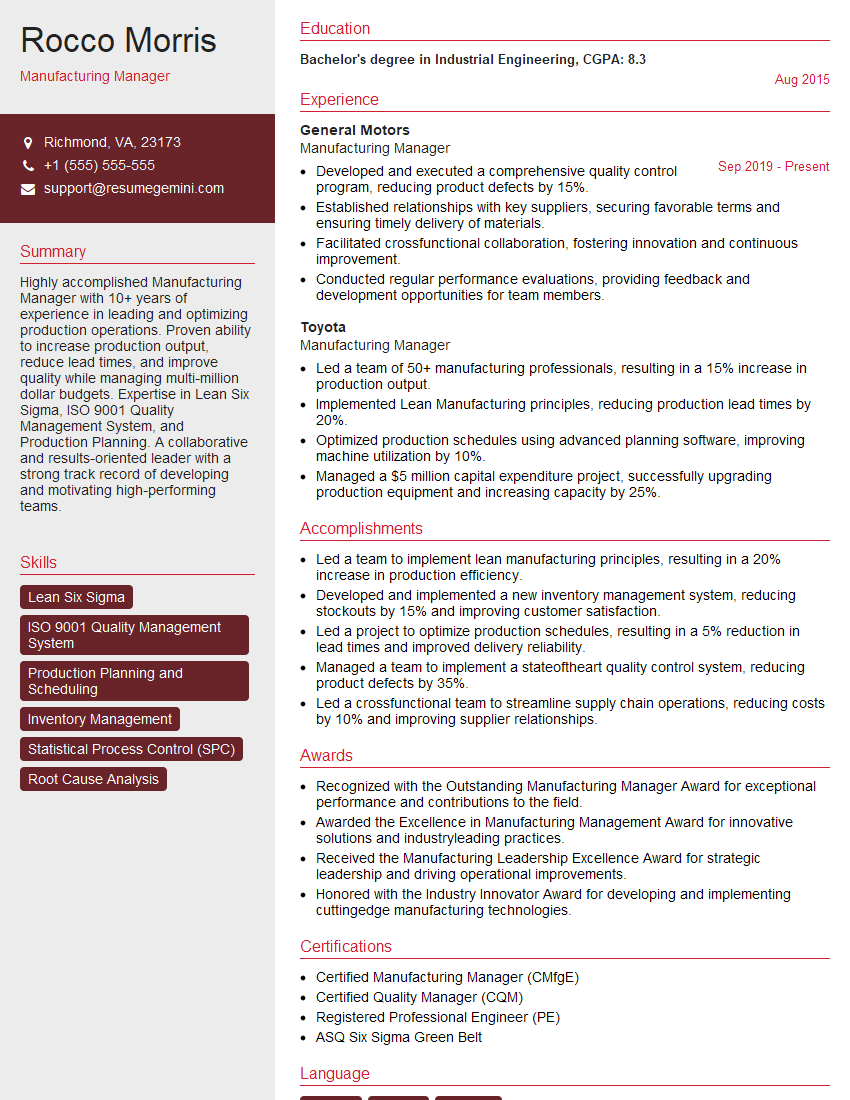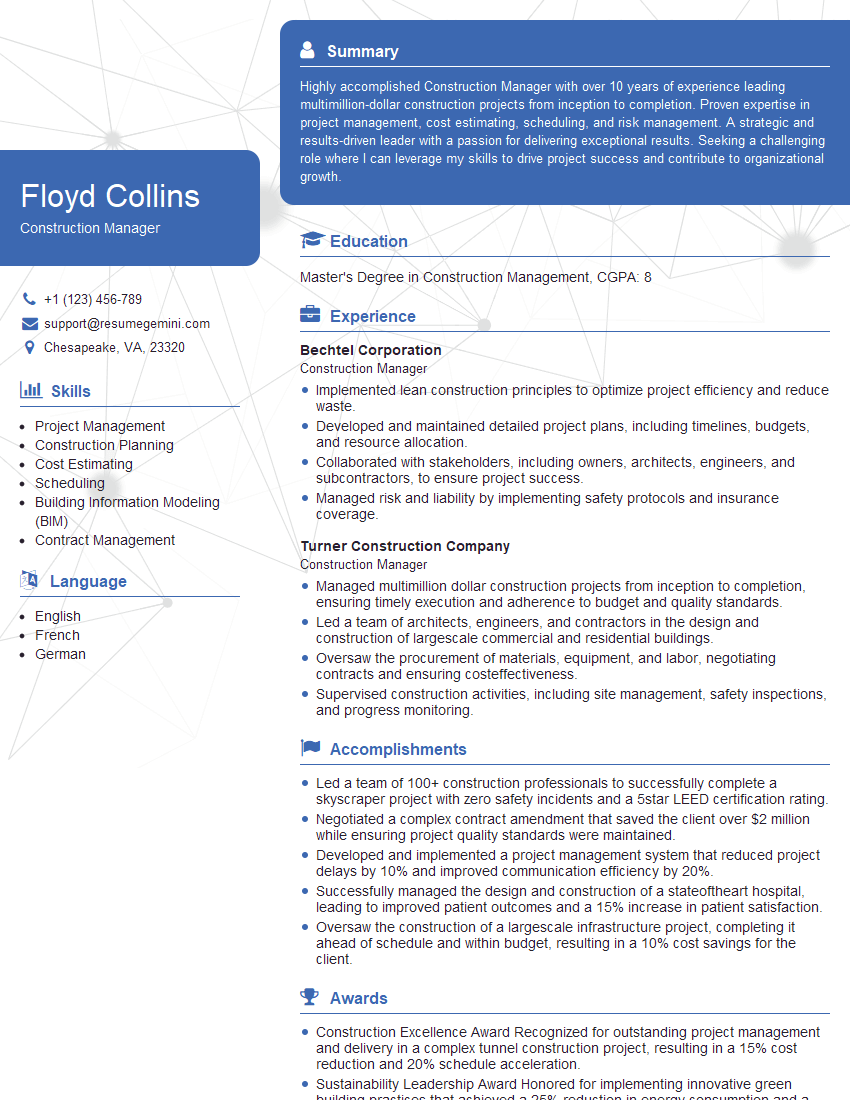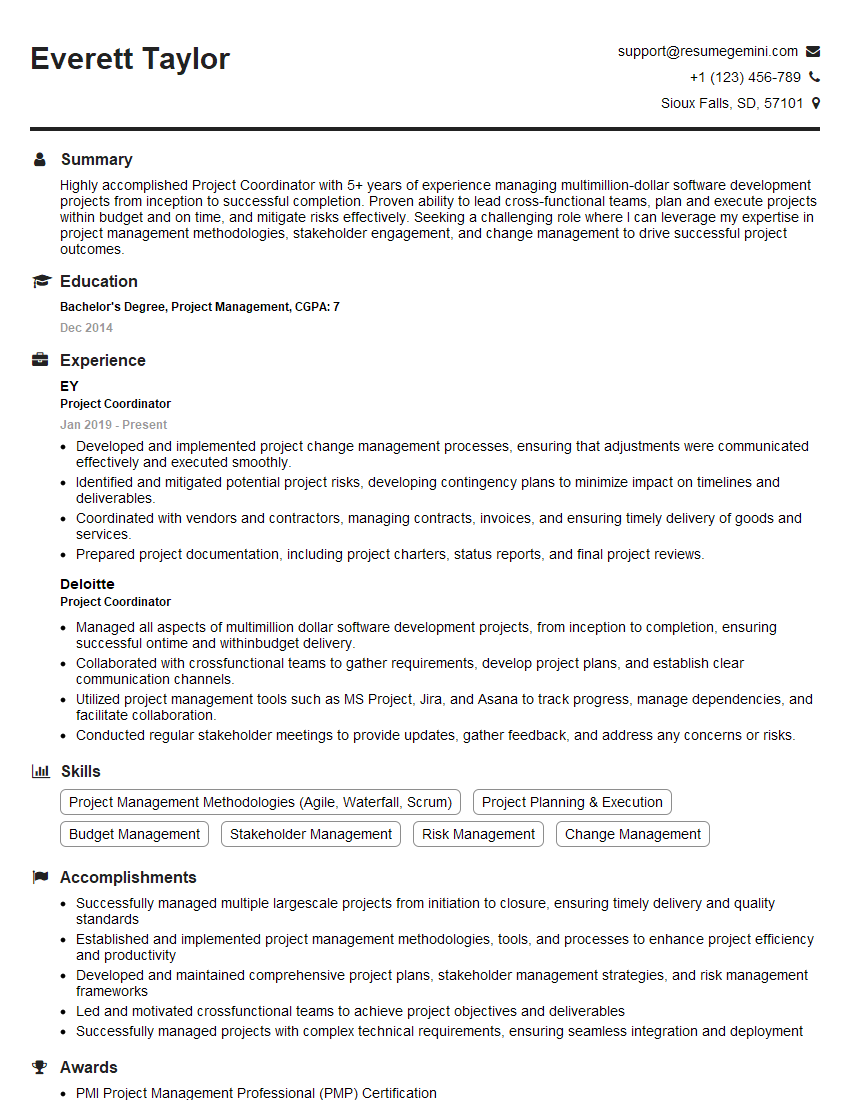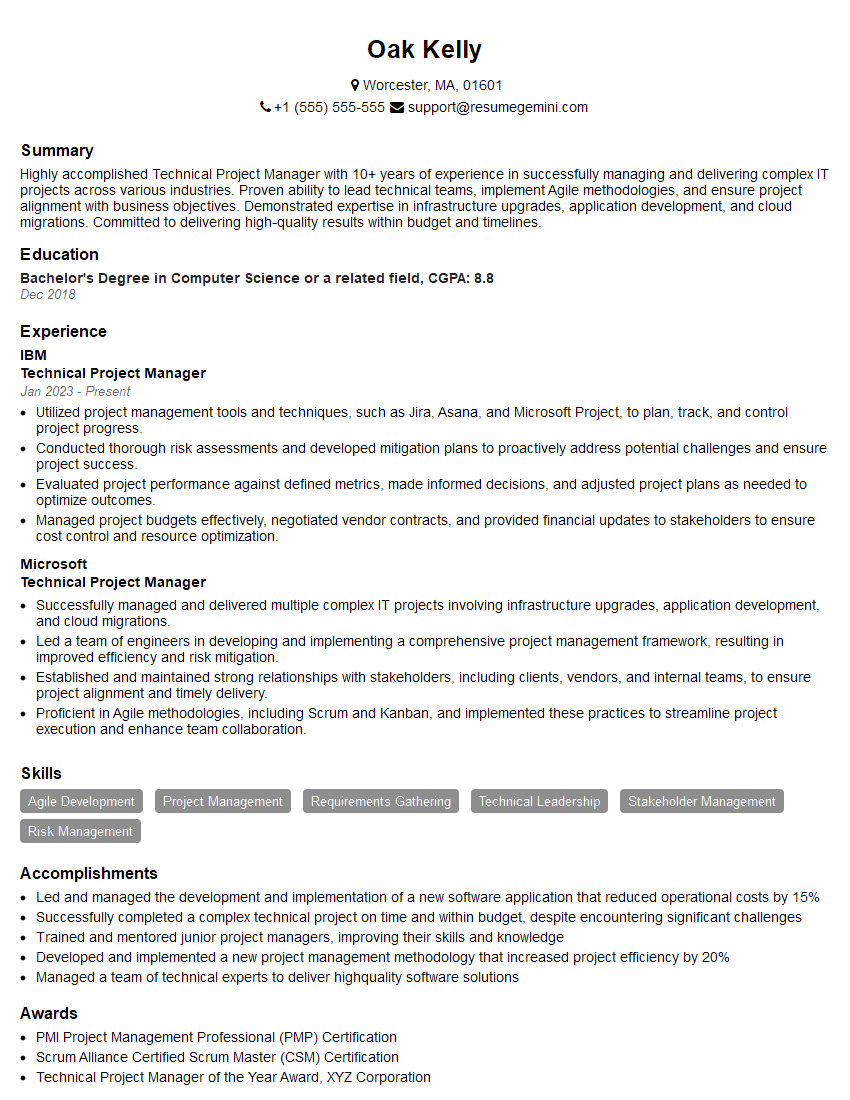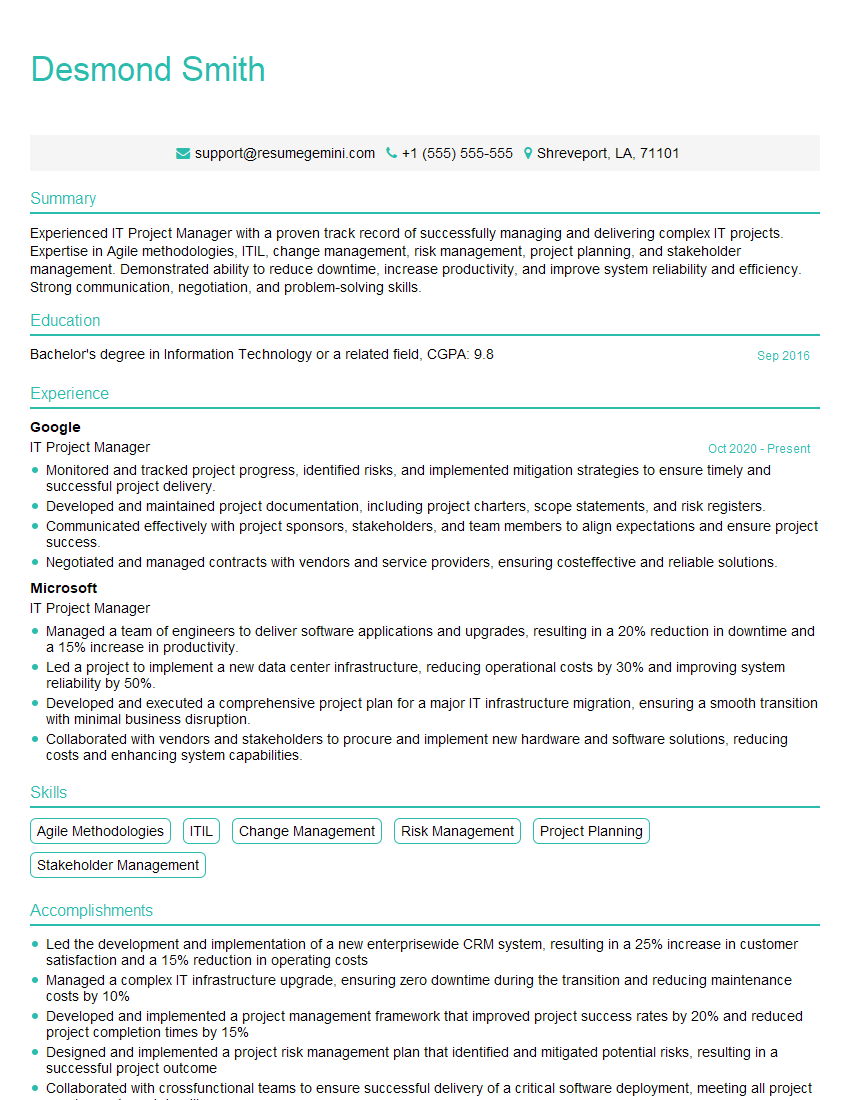Preparation is the key to success in any interview. In this post, we’ll explore crucial Ability to Meet Production Targets and Deadlines interview questions and equip you with strategies to craft impactful answers. Whether you’re a beginner or a pro, these tips will elevate your preparation.
Questions Asked in Ability to Meet Production Targets and Deadlines Interview
Q 1. Describe your approach to prioritizing tasks when facing multiple deadlines.
Prioritizing tasks with multiple deadlines requires a structured approach. I typically use a combination of methods, starting with a clear understanding of each task’s importance and urgency. I employ techniques like the Eisenhower Matrix (urgent/important), which helps categorize tasks into four quadrants: Do, Decide, Delegate, and Delete. This allows me to focus on high-impact, time-sensitive tasks first. Furthermore, I utilize project management software to visually represent deadlines and dependencies, allowing for a bird’s-eye view of all projects and tasks. This visual representation helps in identifying potential conflicts and adjusting priorities proactively.
For example, if I have a critical presentation due tomorrow and a less urgent report due next week, the presentation will take precedence. However, I’ll allocate time for the report as well, breaking it down into manageable chunks to prevent last-minute cramming.
Q 2. How do you handle unexpected delays or obstacles that threaten project deadlines?
Unexpected delays are inevitable in project management. My approach involves immediate action and clear communication. First, I identify the root cause of the delay. Is it a resource constraint, a technical issue, or an unforeseen circumstance? Once identified, I explore potential solutions. This might involve reallocating resources, seeking help from colleagues, or adjusting the project scope.
Crucially, I communicate the delay transparently to stakeholders, explaining the situation, proposed solutions, and the revised timeline. This proactive communication prevents misunderstandings and maintains trust. In one instance, a key supplier failed to deliver materials on time. I immediately contacted alternative suppliers, secured the necessary materials with expedited shipping, and kept the team and stakeholders updated every step of the way. While the deadline was slightly pushed, the project was ultimately completed successfully.
Q 3. What strategies do you employ to estimate project timelines accurately?
Accurate timeline estimation is vital for successful project completion. I employ several strategies. First, I break down the project into smaller, manageable tasks. This granular approach allows for more precise estimations for each task. I then consider historical data from similar projects, factoring in potential challenges and unforeseen delays. This historical context improves the accuracy of my predictions.
I also incorporate buffer time into the schedule. This acknowledges the inherent uncertainty in project execution, providing contingency for unexpected issues. Finally, I involve team members in the estimation process, leveraging their expertise and experience to get a more comprehensive and realistic picture. Think of it like baking a cake: you wouldn’t just guess at the baking time – you’d follow a recipe and consider factors like oven temperature and ingredients.
Q 4. Explain your experience using project management tools to track progress and meet deadlines.
I have extensive experience using various project management tools such as Jira, Asana, and Microsoft Project. These tools allow for efficient task assignment, progress tracking, and deadline management. I use them to create Gantt charts, Kanban boards, and other visual representations of project timelines and task dependencies. This provides a clear overview of the project’s status, identifying potential bottlenecks and facilitating proactive adjustments.
For example, using Jira’s sprint feature, I can track the progress of individual tasks within a specific timeframe, ensuring that deadlines for each sprint are met. The built-in reporting features help in monitoring overall project progress and identifying areas requiring attention.
Q 5. Describe a time you successfully met a challenging deadline under pressure.
In a previous role, we faced a critical deadline for launching a new software application. A major bug emerged just two days before launch. The pressure was immense, but we tackled it systematically. We immediately prioritized fixing the bug, assigning specialized team members to it. We also implemented a rigorous testing procedure to ensure no further issues arose. We worked extended hours, communicating constantly to coordinate efforts. Through collaborative effort and focused determination, we successfully fixed the bug, completed testing, and launched the application on time. This demonstrated the power of teamwork and strategic problem-solving under pressure.
Q 6. How do you communicate project status and potential roadblocks to stakeholders?
Transparent and frequent communication is key to managing stakeholder expectations. I use a combination of methods to keep stakeholders informed. Regular project status meetings are crucial, providing opportunities for updates and addressing concerns. I also utilize email updates for less urgent information and create comprehensive project reports that detail progress, challenges, and anticipated timelines.
For critical updates or potential roadblocks, I prefer direct and immediate communication, even if it’s just a brief phone call or email. This ensures that stakeholders are informed promptly and prevents potential misunderstandings or escalating issues.
Q 7. How do you delegate tasks effectively to ensure timely completion?
Effective delegation involves selecting the right person for the right task. I consider each team member’s skills, experience, and workload before assigning tasks. Clear instructions are crucial; I ensure each person understands the task’s objectives, deadlines, and expected outcomes. I provide necessary resources and support, creating an environment where team members feel empowered to complete their tasks effectively.
Regular check-ins and feedback are vital; I monitor progress, address roadblocks, and provide guidance as needed. This ensures that tasks are completed on time and meet the required quality standards. Delegation is not about simply offloading work; it’s about empowering the team to contribute and share responsibility for project success.
Q 8. What metrics do you use to measure your success in meeting production targets?
Measuring success in meeting production targets relies on a combination of quantitative and qualitative metrics. Quantitative metrics provide objective data, while qualitative metrics offer insights into the process itself.
- On-time delivery rate: This is the percentage of projects or tasks completed by their deadlines. A high percentage indicates strong deadline management.
- Throughput: This measures the volume of work completed within a specific timeframe. A consistent high throughput shows efficient production.
- Defect rate: The number of defects or errors per unit of output. A low defect rate signifies high-quality work, which often correlates with meeting deadlines efficiently.
- Cycle time: The time it takes to complete a single unit of work, from start to finish. Reducing cycle time directly improves overall production speed and meets deadlines better.
- Customer satisfaction: While not directly tied to the *production* process, timely delivery significantly impacts customer satisfaction, indirectly validating the efficiency of meeting targets.
For example, in my previous role, we tracked our on-time delivery rate for software releases. We aimed for 95%, and by implementing a robust project management system, we consistently exceeded this target, achieving an average of 98%.
Q 9. How do you handle conflicting priorities when multiple projects compete for your time?
Conflicting priorities are a common challenge. My approach involves a structured prioritization process. I utilize techniques like the Eisenhower Matrix (urgent/important), MoSCoW method (Must have, Should have, Could have, Won’t have), or simply ranking tasks based on business value and deadlines.
First, I clearly define the scope and deliverables for each project. Then, I analyze the deadlines and dependencies between tasks. I communicate openly with stakeholders to re-negotiate timelines if necessary, explaining the potential impact of limited resources. I might even suggest breaking down large tasks into smaller, more manageable units to better allocate time.
For instance, I once had two projects with overlapping deadlines. Using the Eisenhower Matrix, I identified the truly urgent and important tasks from both projects. I delegated less critical tasks where possible and communicated transparently with stakeholders about potential delays in the less urgent project, adjusting expectations accordingly.
Q 10. Describe your experience with Agile or Waterfall methodologies in meeting deadlines.
I have extensive experience with both Agile and Waterfall methodologies. Waterfall’s linear approach works well for projects with clearly defined requirements and minimal anticipated changes. Its strength lies in predictability and control, ensuring deadlines are met if initial planning is thorough. However, it lacks flexibility for adjustments during the project lifecycle.
Agile, on the other hand, embraces iterative development and adaptability. Its flexibility is invaluable when requirements are likely to change or when new information surfaces. Sprint planning, daily stand-ups, and regular reviews ensure continuous monitoring of progress and timely identification of potential roadblocks. While it can initially seem less structured, its responsiveness makes it great for preventing missed deadlines in dynamic environments.
In practice, I’ve successfully used Waterfall for building large-scale infrastructure projects where precise planning was paramount. For software development, I preferred Agile, regularly utilizing Scrum and Kanban to deliver high-quality products on time, even with evolving client needs.
Q 11. How do you identify potential bottlenecks in a production process and address them proactively?
Identifying and proactively addressing bottlenecks is crucial for on-time production. My approach involves constant monitoring and analysis of the production process.
- Process Mapping: Visually mapping the entire production flow helps identify potential bottlenecks. This can reveal areas with excessive wait times or resource constraints.
- Data Analysis: Analyzing key metrics (like cycle time, throughput, and defect rate) pinpoints areas that consistently underperform or cause delays.
- Team Feedback: Regularly engaging with the team to understand their challenges and constraints is critical. Often, frontline workers are the first to notice bottlenecks.
For example, in a previous project, data analysis revealed a bottleneck at the quality assurance stage. By optimizing the testing process and adding an extra QA resource, we significantly reduced the cycle time and avoided missed deadlines.
Q 12. What is your process for identifying and mitigating risks that could impact deadlines?
Risk management is an integral part of meeting deadlines. My process involves proactively identifying, assessing, and mitigating potential risks.
- Risk Identification: Brainstorming sessions with the team, reviewing past project experiences, and analyzing potential external factors (market changes, resource availability) help identify potential risks.
- Risk Assessment: I assess the likelihood and potential impact of each identified risk. This helps prioritize mitigation efforts.
- Risk Mitigation: Developing contingency plans for high-priority risks. This might involve allocating buffer time, securing backup resources, or developing alternative solutions.
- Risk Monitoring: Regularly monitoring the identified risks to ensure that mitigation strategies are effective and adapt as needed.
For instance, in a large-scale project, we identified the risk of a key supplier delaying component delivery. We mitigated this by securing a secondary supplier and building a buffer into the project schedule, ensuring that even with delays, the project would remain on track.
Q 13. How do you balance speed and quality when working to meet production targets?
Balancing speed and quality is a delicate act, but crucial for meeting production targets effectively. Cutting corners to increase speed often leads to compromised quality and, ironically, can even cause delays in the long run (due to rework or fixing errors).
My approach involves focusing on efficiency rather than simply speed. This involves streamlining processes, optimizing workflows, and leveraging automation where possible. Quality checks and testing should be integrated throughout the process, not just at the end. This allows for early detection and correction of errors, minimizing rework and maintaining quality without significant time penalties.
An example of this is employing continuous integration/continuous delivery (CI/CD) pipelines in software development, automating testing and deployment to accelerate delivery while ensuring high software quality.
Q 14. How do you stay organized and manage your workload to prevent missed deadlines?
Staying organized and managing workload effectively is paramount. I use a combination of tools and techniques.
- Project Management Software: Tools like Jira, Asana, or Trello provide a centralized platform for task management, deadline tracking, and team collaboration.
- Time Management Techniques: Techniques like the Pomodoro Technique or time blocking help allocate time effectively and maintain focus.
- Prioritization and Delegation: Prioritizing tasks based on urgency and importance, and delegating tasks where appropriate, prevents overload and ensures timely completion.
- Regular Review and Adjustment: Regularly reviewing my schedule and progress allows for identifying potential issues early on and making necessary adjustments to avoid missed deadlines.
For example, I utilize a Kanban board to visualize my workload, prioritize tasks based on urgency and value, and track my progress visually. This helps me stay organized and adapt quickly to changing priorities.
Q 15. What is your preferred method for tracking your progress against project milestones?
My preferred method for tracking progress against project milestones involves a multi-faceted approach leveraging both visual and data-driven tools. I typically utilize a combination of Gantt charts for visualizing the project timeline and dependencies, and project management software like Jira or Asana for detailed task tracking and progress updates. These tools allow me to clearly see the critical path, identify potential bottlenecks early on, and monitor individual task completion against scheduled deadlines. For example, in a recent software development project, the Gantt chart helped us identify a dependency conflict between the database migration and front-end development, allowing us to proactively adjust the schedule and prevent a delay. Furthermore, regular status meetings, where team members provide concise updates on their tasks, are crucial for staying on track. This proactive monitoring ensures that any deviation from the plan is identified and addressed promptly.
Career Expert Tips:
- Ace those interviews! Prepare effectively by reviewing the Top 50 Most Common Interview Questions on ResumeGemini.
- Navigate your job search with confidence! Explore a wide range of Career Tips on ResumeGemini. Learn about common challenges and recommendations to overcome them.
- Craft the perfect resume! Master the Art of Resume Writing with ResumeGemini’s guide. Showcase your unique qualifications and achievements effectively.
- Don’t miss out on holiday savings! Build your dream resume with ResumeGemini’s ATS optimized templates.
Q 16. Have you ever experienced a missed deadline? How did you handle it and what did you learn?
Yes, I have experienced a missed deadline. In a previous project, a critical third-party vendor delivered a necessary component late. My immediate response was to communicate transparently with all stakeholders, including clients and management, about the delay and its impact. We then implemented a mitigation plan which involved prioritizing the remaining tasks, working extended hours, and creatively restructuring our workflow to minimize the overall impact on the final deliverable. We ultimately made up some lost time, but the delay resulted in a slightly reduced scope. The key learning was the importance of robust risk management, including contingency planning for potential external delays and establishing stronger communication channels with vendors to proactively monitor their progress.
Q 17. Describe a situation where you had to make difficult decisions to meet a critical deadline.
During the launch of a new product, we faced a critical bug just days before the official release date. Fixing it required a significant amount of coding and testing, pushing us against our deadline. The difficult decision was to deprioritize several less critical features to focus solely on resolving the critical bug. This involved difficult conversations with the team, explaining the necessity of the decision and ensuring everyone understood the importance of meeting the deadline despite the reduced scope. It required prioritization based on risk and impact, a clear communication strategy, and a high level of team collaboration to ensure success. While some features were delayed to a later release, launching the core product on time, free from critical issues, allowed us to maintain customer trust and brand integrity.
Q 18. How do you motivate yourself and your team to meet tight deadlines?
Motivating myself and my team to meet tight deadlines involves a multifaceted approach focused on clear communication, collaboration, and recognition. Firstly, I ensure everyone understands the importance of the deadline and the overall project goals. Transparency is key – explaining the consequences of delays and the benefits of successful timely delivery fosters a sense of shared responsibility. I foster a collaborative environment where team members feel comfortable communicating challenges and seeking assistance. Regular check-ins, both individually and as a team, provide opportunities to address roadblocks and adjust strategies as needed. Finally, I emphasize acknowledging and celebrating achievements, both big and small, to reinforce positive momentum and team morale. This could involve simple verbal praise, small team celebrations or rewards based on the project’s success. Creating a positive and supportive environment plays a crucial role in team motivation during high-pressure situations.
Q 19. How familiar are you with different project management methodologies (e.g., Kanban, Scrum)?
I’m familiar with several project management methodologies, including Kanban and Scrum. I have practical experience using Scrum in agile software development projects. I understand the principles of Scrum, including sprints, daily stand-ups, sprint reviews, and retrospectives. The iterative nature of Scrum allows for flexibility and adaptation to changing requirements, helping us meet deadlines effectively. Kanban, with its focus on visualizing workflow and limiting work in progress, has helped me streamline project execution and improve efficiency in various projects. The choice of methodology depends heavily on the project’s nature, size, and team dynamics. I adapt my approach based on the specific context, selecting the methodology that best suits the project’s needs.
Q 20. How do you utilize data and analytics to improve your ability to meet deadlines?
Data and analytics play a vital role in improving my ability to meet deadlines. I use data to identify trends, predict potential delays, and refine processes. For instance, by analyzing historical project data, I can identify common bottlenecks or areas prone to delays. This allows me to proactively address these issues in future projects, potentially through process improvements, resource allocation adjustments or more effective risk management. Project management software provides valuable data on task completion rates, resource utilization, and overall project progress. By analyzing this data, I can identify areas that require attention and make data-driven decisions to optimize workflow and stay on schedule. Regular monitoring and analysis enable continuous improvement and informed decision-making, enhancing the team’s ability to meet deadlines consistently.
Q 21. What steps do you take to ensure the quality of your work while meeting deadlines?
Ensuring quality while meeting deadlines requires a proactive approach that incorporates quality checks at various stages of the project lifecycle. This includes establishing clear quality standards from the outset, defining acceptance criteria for deliverables, and building in time for thorough testing and reviews. Utilizing agile methodologies allows for iterative development, integrating testing and feedback loops throughout the process, thereby catching and addressing quality issues early on. Automated testing where applicable can significantly reduce testing time without compromising quality. Prioritizing thorough documentation for each task and the overall project enables efficient knowledge sharing, simplifies handover processes, and supports maintaining quality even with team changes. This proactive approach ensures that the focus on speed doesn’t compromise the quality of the final product or service.
Q 22. How do you handle pressure and stress when faced with competing deadlines?
When faced with competing deadlines, I employ a prioritized, structured approach. Instead of panicking, I view pressure as a motivator. My strategy begins with a clear assessment of all deadlines, ranking them by criticality and impact. I use tools like Gantt charts to visualize dependencies and potential bottlenecks. Then, I break down large tasks into smaller, manageable chunks. This allows me to track progress effectively and adjust my schedule as needed. For instance, in a previous project involving simultaneous software releases and marketing campaigns, I prioritized the software beta launch as the most time-sensitive. By allocating resources accordingly and clearly communicating priorities to my team, we successfully met both deadlines. Furthermore, I regularly communicate with stakeholders regarding progress and any potential roadblocks. This proactive communication ensures transparency and helps manage expectations.
Q 23. Describe your experience with resource allocation and capacity planning.
Resource allocation and capacity planning are crucial for timely project completion. My experience involves using various techniques, from simple spreadsheets to sophisticated project management software. I begin by identifying the resources required—personnel, tools, budget—for each project. I then assess the capacity of each resource. For instance, I might determine that a specific developer can only dedicate 50% of their time to Project X due to concurrent responsibilities. I leverage this data to create realistic schedules that account for resource availability. Capacity planning involves forecasting resource needs throughout the project lifecycle, and proactively identifying potential shortages. In one project, we anticipated a surge in demand for testing resources towards the end. By proactively engaging additional testers and scheduling their involvement early, we avoided a potential bottleneck and stayed on schedule. This often requires careful negotiation and collaboration across teams.
Q 24. How do you collaborate with other teams or departments to achieve shared deadlines?
Collaboration is key to meeting shared deadlines. I believe in fostering open communication and establishing clear expectations from the start. This involves regularly scheduling meetings with other teams to discuss progress, potential roadblocks, and dependencies. I use collaborative tools such as shared project management platforms and instant messaging to ensure seamless communication. For example, in a previous campaign where marketing, sales, and product development needed to align on a product launch, we created a shared document outlining milestones and responsibilities. Weekly check-ins ensured everyone was on the same page, allowing us to address issues proactively and keep the project moving smoothly. Active listening and a willingness to compromise are vital in achieving these shared goals.
Q 25. How do you adapt your approach to meeting deadlines based on the project’s complexity and scope?
My approach adapts to project complexity and scope. For smaller, less complex projects, a simpler, agile methodology might suffice. However, for large-scale, intricate projects, I employ a more structured, phased approach, leveraging project management methodologies like Waterfall or hybrid approaches. For example, a small website redesign might require a more flexible timeline, whereas a large software development project requires detailed planning, rigorous testing, and multiple review cycles. I break down large projects into smaller, more manageable phases, setting interim deadlines for each phase. This allows for more granular progress tracking and reduces the risk of significant delays. Regularly reviewing progress against the plan is essential for making timely adjustments.
Q 26. How do you use technology to enhance productivity and meet deadlines efficiently?
Technology plays a vital role in enhancing productivity and meeting deadlines. I leverage various tools, such as project management software (e.g., Jira, Asana), collaboration platforms (e.g., Slack, Microsoft Teams), and time tracking applications (e.g., Toggl). These tools allow for better task organization, resource allocation tracking, and progress visualization. For instance, using Jira allows me to assign tasks, track progress, and identify potential bottlenecks early. This proactive monitoring helps prevent delays. Furthermore, automation tools can streamline repetitive tasks, freeing up time for more strategic work. In my experience, the effective use of technology consistently leads to improved efficiency and on-time project completion.
Q 27. What are your strategies for proactively identifying and addressing potential issues that might impact deadlines?
Proactive risk management is essential for meeting deadlines. My strategies include regular risk assessments throughout the project lifecycle. This involves identifying potential issues, such as resource constraints, technical challenges, or external dependencies. I then assess the likelihood and impact of each risk. For instance, in a project involving third-party API integration, we identified the risk of API downtime. We mitigated this risk by establishing a contingency plan, including an alternative data source. Developing mitigation strategies for each identified risk and having a clear escalation plan when unexpected challenges arise ensures resilience and reduces the chance of significant delays.
Q 28. Describe a time when you had to adjust your plans or strategy to meet a changing deadline.
In a previous project, the client unexpectedly requested a significant scope change mid-project, necessitating a compressed timeline. Instead of panicking, I immediately convened a meeting with the team to assess the impact of the change on the existing schedule. We collaboratively prioritized the new requirements against the existing ones, identifying tasks that could be deferred or simplified to meet the revised deadline. This required open communication with the client to manage expectations, ensuring they understood the implications of the changes on the project timeline. We successfully adjusted our plans, re-prioritizing tasks, and leveraging overtime strategically, resulting in successful project completion despite the unexpected change in deadline.
Key Topics to Learn for Ability to Meet Production Targets and Deadlines Interview
- Time Management Strategies: Explore various time management techniques like Pomodoro, Eisenhower Matrix, and time blocking. Understand how to prioritize tasks effectively and allocate time realistically.
- Prioritization and Task Delegation: Learn to identify high-impact tasks, delegate effectively when possible, and understand the importance of saying “no” to prevent overload.
- Proactive Problem Solving: Discuss anticipating potential roadblocks, developing contingency plans, and effectively communicating challenges to stakeholders before they become critical issues.
- Project Planning & Tracking: Understand different project management methodologies (Agile, Waterfall, etc.) and how to use tools to track progress, identify delays, and adjust timelines as needed.
- Communication & Collaboration: Highlight the importance of clear and consistent communication with team members and management regarding progress, challenges, and potential delays. Emphasize teamwork and collaborative problem-solving.
- Stress Management & Resilience: Discuss strategies for managing stress under pressure and maintaining productivity even when facing tight deadlines. Explain how to adapt to changing priorities and unexpected challenges.
- Data Analysis & Performance Measurement: Explain how to track your own performance against targets, analyze data to identify areas for improvement, and use this information to refine your workflow and time management strategies.
Next Steps
Mastering the ability to meet production targets and deadlines is crucial for career advancement. It demonstrates reliability, efficiency, and a strong work ethic – qualities highly valued by employers. To significantly boost your job prospects, create an ATS-friendly resume that clearly showcases your skills and accomplishments in this area. ResumeGemini is a trusted resource to help you build a professional and impactful resume. We offer examples of resumes tailored to highlight your ability to meet production targets and deadlines – take advantage of these resources to present yourself effectively to potential employers.
Explore more articles
Users Rating of Our Blogs
Share Your Experience
We value your feedback! Please rate our content and share your thoughts (optional).


